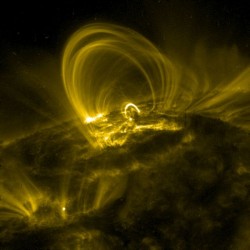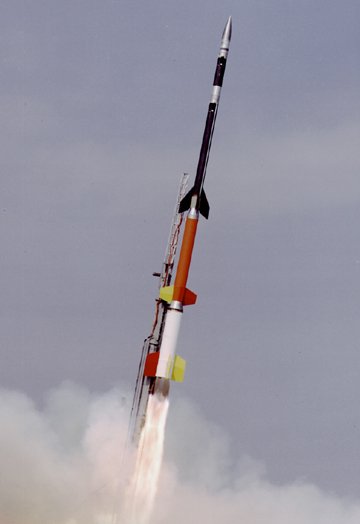[/caption]
Solar physicists will have the unprecedented opportunity to peer inside one of the most mysterious regions in the Sun’s atmosphere. Separating the chromosphere (at a temperature of a few thousand Kelvin) and the extended corona (at a temperature of over a million Kelvin) is a very thin layer about 5000 km above the photosphere (a.k.a. the Sun’s “surface”). The transition region dictates the characteristics of the hot plasma passing from the Sun into space and is right at the start of the solar-terrestrial chain, controlling space weather. We are unable to directly observe the transition region as it doesn’t radiate in wavelengths observable from the Earth’s surface, but it does emit UV radiation observable from space. So a group of solar researchers are packing some very sensitive instrumentation into a sounding rocket that will very briefly take some snapshots of the transition region. But they will have to be quick, from instrument deployment to re-entry, only eight minutes will be allowed to take the necessary UV spectroscopic observations…
To start us off, Jonathan Cirtain from the Marshall Space Flight Center explains this new mission in a nutshell:
“Early next year, we’re going to launch an experimental telescope that can measure vector magnetic fields in the transition region.” – Cirtain.
But why? Hasn’t the transition region been observed before? Actually, no. The surface of the Sun has been tirelessly studied, as has the solar atmosphere, but the thin layer separating the two has, so far, remained hidden from solar astronomers. “Just bad luck, really,” says Cirtain as he explains why the transition region has remained a mystery for so long. “Gas in the transition region doesn’t produce many strong spectral lines that we can see at visible wavelengths.” But it does radiate UV emission that can be observed from space, so Cirtain hopes his research group will be the first to peer right inside by pushing into space.

The transition region is critical to the understanding of the magnetic structure of the Sun and its corona. Below this thin layer, plasma pressure dominates, above it, magnetic pressure dominates. This means that above the transition region, the characteristics of the Sun’s magnetic field overwhelm the decreasing plasma pressure. The corona becomes a highly structured entity from the transition region and upward, which can be seen in the structure of magnetic coronal loops (pictured).
But what will they be measuring? How can the magnetic structure inside the transition region be seen? The instrument to be launched is called the Solar Ultraviolet Magnetograph Investigation (SUMI) and it is designed to measure the magnetic phenomenon of “Zeeman Splitting.” The Zeeman effect occurs when radiating plasma is in the presence of a strong magnetic field. So in the case of SUMI, the instrument will observe the UV emission from the transition region and detect the fine-scale splitting of the UV spectroscopic emission lines. The stronger the magnetic field, the greater the splitting.
SUMI can also measure the polarization of the split lines, so Cirtain’s team will have all the information they’ll ever need about the magnetic field in the transition region: both magnetic filed strength and direction. So far, so good.
But how is Cirtain planning on getting SUMI into space? To possibly make it cheap, and because SUMI is a comparatively simple instrument, it won’t need to be in space long. So the plan is to blast it into the lowest reaches of space on a sub-orbital flight inside the nose cone of a Black Brant sounding rocket. 68 seconds and 300 km (185 miles) into the flight, SUMI will be jettisoned. “We’ll be above more than 99.99% of Earth’s atmosphere. From that moment, we’ve only got 8 minutes to work with. We’ll target an active region and start taking data,” Cirtain added.
Carrying out short sounding rocket missions is not new to solar physics, some of the very first space-based observations of the Sun could only come from high altitude rockets. However, Cirtain will be nervous to see SUMI disappear into the stratosphere at 5,000 mph and has dubbed the flight the “Eight minutes of terror.”
So, from one of the simplest and cheapest observation campaigns, the mysterious transition region may start to give us some answers…
Source: NASA


It is odd Astrofiend. As Cirtain said, “it’s bad luck” that this zone hadn’t been studied, it is a bit odd too. The TR holds the key to coronal heating and solar wind acceleration, so these results would be great.. When I was working on TRACE data, I was surprised that the probe didn’t have a spectrometer on board capable of seeing the TR. Although a sounding rocket is a good idea, it probably wont revolutionize solar physics quite yet…
Cheers!
Ian
“so Cirtain’s team will have all the information they’ll ever need about the magnetic field in the transition region: both magnetic filed strength and direction.”
All the data they’ll ever need?! I bet they wish they had this thing flying on Hinode, STEREO or some other dedicated solar observation spacecraft so they could get more data than an eight minute flight will allow…
Still, great to see that somebody is chasing some interesting science – best of luck to them.
From what’s been described, it sounds like a critically important region in the scheme of solar physics – I’m surprised that it remains completely unexplored…
Hi! I am bit confused by both the article and the comments thereof…I thought that TRACE was a spacecraft dedicated to TR and Coronal exploration and also that such an important region is not so far studied….I am not a solar physicist still was very suprised …
I worked on this project as a summer student and can offer a little insight as to why it was not flown on a satellite. The main problem is that it is too experimental. No one has ever tried to do magnetic field mapping in the UV before (it doesn’t make sense unless you’re in a vacuum) . In general, the cost of putting it on a satellite is too much for an instrument that no one’s ever made before. This project is much more of a proof of concept and if it works, maybe a similar instrument will earn a place on a future satellite.